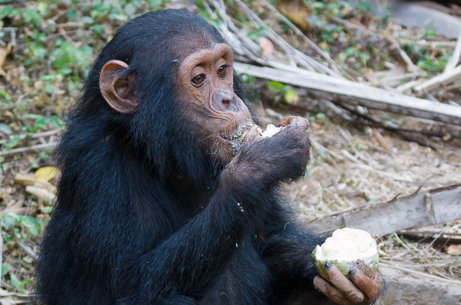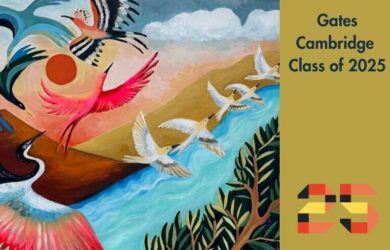
New research shows that chimpanzees search for the right tools from a key plant species when preparing to ‘ant dip’ - a crafty technique enabling them to feast on army ants without getting bitten.
New research shows that chimpanzees search for the right tools from a key plant species when preparing to ‘ant dip’ – a crafty technique enabling them to feast on army ants without getting bitten. The study shows that army ants are not a poor substitute for preferred foods, but a staple part of chimpanzee diets.
West African chimpanzees will search far and wide to find Alchornea hirtella, a spindly shrub whose straight shoots provide the ideal tools to hunt aggressive army ants in an ingenious fashion, new research shows.
The plant provides the animals with two different types of tool, a thicker shoot for ‘digging’ and a more slender tool for ‘dipping’.
On locating an army ant colony, chimpanzees will dig into the nest with the first tool – aggravating the insects. They then dip the second tool into the nest, causing the angry ants to swarm up it. Once the slender shoot is covered in ants, the chimpanzees pull it out and wipe their fingers along it: scooping up the ants until they have a substantial handful that goes straight into the mouth in one deft motion.
This technique – ‘ant dipping’ – was previously believed to be a last resort for the hungry apes, only exploited when the animal’s preferred food of fruit couldn’t be found. But the latest study, based on over 10 years of data, shows that, in fact, army ants are a staple in the chimpanzee diet – eaten all year round regardless of available sources of fruit. Ants may be an important source of essential nutrients not available in the typical diet, say researchers, as well as a potential source of protein and fats.
The new research, published today in the American Journal of Primatology, was led by Gates Cambridge Alumna Dr Kathelijne Koops [2006] from the University of Cambridge’s Division of Biological Anthropology who is now a Junior Research Fellow of Homerton College.
“Ant dipping is a remarkable feat of problem-solving on the part of chimpanzees,” said Koops. “If they tried to gather ants from the ground with their hands, they would end up horribly bitten with very little to show for it. But by using a tool set, preying on these social insects may prove as nutritionally lucrative as hunting a small mammal – a solid chunk of protein.”
Koops points out that if Alchornea hirtella is nowhere to be found, chimps will fashion tools from other plants – but seemingly only after an exhaustive search for their preferred tool provider.
Previous research has shown that chimpanzees will actually select longer tools for faster, more aggressive types of army ants. The average ‘dipping’ tool length across the study was 64 centimetres, but dipping tools got up to 76 cm.
The question for Koops is one of animal culture: how do chimpanzees acquire knowledge of such sophisticated techniques?
“Scientists have been working on ruling out simple environmental and genetic explanations for group differences in behaviours, such as tool use, and the evidence is pointing strongly towards it being cultural,” said Koops. “They probably learn tool use behaviours from their mother and others in the group when they are young.”
The research for the ant-dipping study – which took place in Guinea’s Nimba mountains – proved challenging, as the chimpanzees were not habituated to people – so the team acted almost as archaeologists, studying ‘exploited’ ants nests to measure abandoned tool sets and “sifting through faeces for ants heads”.
To further study these illusive creatures, Koops set up cameras to take extensive video footage of the chimpanzees and their tool use. In doing so, she managed to capture a chimpanzee who has constructed a tool with which to investigate the camera itself – prodding it curiously and then sniffing the end of the tool (VIDEO).
“This study is part of a big ongoing research project. The next stages will involve looking at social opportunities to learn: how much time do youngsters spend within arm’s length of other individuals; how much time do they spend close to their mother; as well as innate predispositions to explore and engage with objects,” said Koops. “By studying our closest living relatives we gain a window into the evolutionary past which allows us to shed light on the origins of human technology and material culture.”
Picture credit: Wiki Commons.












